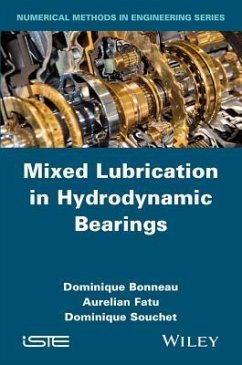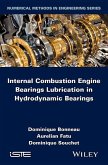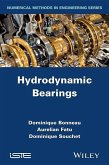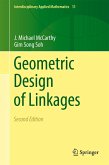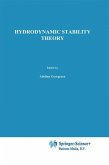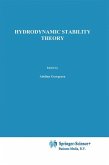- Gebundenes Buch
- Merkliste
- Auf die Merkliste
- Bewerten Bewerten
- Teilen
- Produkt teilen
- Produkterinnerung
- Produkterinnerung
This Series provides the necessary elements to the development and validation of numerical prediction models for hydrodynamic bearings. This book is dedicated to the mixed lubrication.
Andere Kunden interessierten sich auch für
![Internal Combustion Engine Bearings Lubrication in Hydrodynamic Bearings Internal Combustion Engine Bearings Lubrication in Hydrodynamic Bearings]() Dominique BonneauInternal Combustion Engine Bearings Lubrication in Hydrodynamic Bearings158,99 €
Dominique BonneauInternal Combustion Engine Bearings Lubrication in Hydrodynamic Bearings158,99 €![Hydrodynamic Bearings Hydrodynamic Bearings]() Dominique BonneauHydrodynamic Bearings158,99 €
Dominique BonneauHydrodynamic Bearings158,99 €![Geometric Design of Linkages Geometric Design of Linkages]() J. Michael McCarthyGeometric Design of Linkages76,99 €
J. Michael McCarthyGeometric Design of Linkages76,99 €![QUANTUM HYDRODYNAMIC EQUATION AND ITS MATHEMATICAL THEORY QUANTUM HYDRODYNAMIC EQUATION AND ITS MATHEMATICAL THEORY]() Guo BolingQUANTUM HYDRODYNAMIC EQUATION AND ITS MATHEMATICAL THEORY102,99 €
Guo BolingQUANTUM HYDRODYNAMIC EQUATION AND ITS MATHEMATICAL THEORY102,99 €![Hydrodynamic stability theory Hydrodynamic stability theory]() A. GeorgescuHydrodynamic stability theory153,99 €
A. GeorgescuHydrodynamic stability theory153,99 €![Hydrodynamic stability theory Hydrodynamic stability theory]() A. GeorgescuHydrodynamic stability theory153,99 €
A. GeorgescuHydrodynamic stability theory153,99 €![Discrete Mechanics Discrete Mechanics]() Jean-Paul CaltagironeDiscrete Mechanics158,99 €
Jean-Paul CaltagironeDiscrete Mechanics158,99 €-
-
-
This Series provides the necessary elements to the development and validation of numerical prediction models for hydrodynamic bearings. This book is dedicated to the mixed lubrication.
Produktdetails
- Produktdetails
- Verlag: Wiley
- Seitenzahl: 240
- Erscheinungstermin: 15. September 2014
- Englisch
- Abmessung: 236mm x 157mm x 20mm
- Gewicht: 454g
- ISBN-13: 9781848216822
- ISBN-10: 1848216823
- Artikelnr.: 41029753
- Herstellerkennzeichnung
- Libri GmbH
- Europaallee 1
- 36244 Bad Hersfeld
- gpsr@libri.de
- Verlag: Wiley
- Seitenzahl: 240
- Erscheinungstermin: 15. September 2014
- Englisch
- Abmessung: 236mm x 157mm x 20mm
- Gewicht: 454g
- ISBN-13: 9781848216822
- ISBN-10: 1848216823
- Artikelnr.: 41029753
- Herstellerkennzeichnung
- Libri GmbH
- Europaallee 1
- 36244 Bad Hersfeld
- gpsr@libri.de
Dominique Bonneau is Professor Emeritus specializing in the numerical modelization of lubrication problems who has worked as a teacher-researcher at the IUT of Angoulême and at the Institute PPRIME (Laboratory of Mechanics of Solids) of the University of Poitiers-CNRS-ENSMA in France. Aurelian Fatu is Professor and a researcher at the Institute PPRIME specializing in the modeling of problems of lubrication for engine bearings and for systems' sealing devices. Dominique Souchet specializes in the modeling of thermo-hydrodynamic lubrication of journal and thrust bearings with Newtonian or non-Newtonian fluids. He is a university lecturer and researcher at the Institute PPRIME.
Preface ix
Nomenclature xi
Chapter 1 Introduction 1
1.1 Lubrication regimes - Stribeck curve 1
1.2 Topography of rough surfaces 3
1.3 Bibliography 18
Chapter 2 Computing the Hydrodynamic Pressure 19
2.1 Patir and Cheng stochastic model 20
2.2 Model based on a direct computation of the flow factors 34
2.3 Homogenization method 66
2.4 Comparison between the flow factors obtained with Patir and Cheng
computation and homogenization models 87
2.5 Example of pressure profiles obtained from flow factors calculated with
Patir and Cheng, direct computation and homogenization models 90
2.6 Comparison with deterministic computations 94
2.7 Bibliography 99
Chapter 3 Computing the Contact Pressure 103
3.1 Concept of sum surface 104
3.2 Elastic contact model proposed by Greenwood and Williamson 105
3.3 Elasto-plastic contact model proposed by Robbe-Valloire el al 108
3.4 Elasto-plastic double-layer contact model proposed by Progri et al 115
3.5 Model based discrete Fourier transformation 119
3.6 Deterministic model based on finite elements 124
3.7 Using the contact models 128
3.8 Influence of the roughness deformation generated by the contact
pressure on the flow factors 149
3.9 Using the contact models in an industrial context 151
3.10 Bibliography 153
Chapter 4 Wear 155
4.1 General concepts about wear 156
4.2 Running-in 163
4.3 Experimental determination of the Archard coefficient 165
4.4 Numerical modeling of the wear 168
4.5 Bibliography 182
Index 183
Nomenclature xi
Chapter 1 Introduction 1
1.1 Lubrication regimes - Stribeck curve 1
1.2 Topography of rough surfaces 3
1.3 Bibliography 18
Chapter 2 Computing the Hydrodynamic Pressure 19
2.1 Patir and Cheng stochastic model 20
2.2 Model based on a direct computation of the flow factors 34
2.3 Homogenization method 66
2.4 Comparison between the flow factors obtained with Patir and Cheng
computation and homogenization models 87
2.5 Example of pressure profiles obtained from flow factors calculated with
Patir and Cheng, direct computation and homogenization models 90
2.6 Comparison with deterministic computations 94
2.7 Bibliography 99
Chapter 3 Computing the Contact Pressure 103
3.1 Concept of sum surface 104
3.2 Elastic contact model proposed by Greenwood and Williamson 105
3.3 Elasto-plastic contact model proposed by Robbe-Valloire el al 108
3.4 Elasto-plastic double-layer contact model proposed by Progri et al 115
3.5 Model based discrete Fourier transformation 119
3.6 Deterministic model based on finite elements 124
3.7 Using the contact models 128
3.8 Influence of the roughness deformation generated by the contact
pressure on the flow factors 149
3.9 Using the contact models in an industrial context 151
3.10 Bibliography 153
Chapter 4 Wear 155
4.1 General concepts about wear 156
4.2 Running-in 163
4.3 Experimental determination of the Archard coefficient 165
4.4 Numerical modeling of the wear 168
4.5 Bibliography 182
Index 183
Preface ix
Nomenclature xi
Chapter 1 Introduction 1
1.1 Lubrication regimes - Stribeck curve 1
1.2 Topography of rough surfaces 3
1.3 Bibliography 18
Chapter 2 Computing the Hydrodynamic Pressure 19
2.1 Patir and Cheng stochastic model 20
2.2 Model based on a direct computation of the flow factors 34
2.3 Homogenization method 66
2.4 Comparison between the flow factors obtained with Patir and Cheng
computation and homogenization models 87
2.5 Example of pressure profiles obtained from flow factors calculated with
Patir and Cheng, direct computation and homogenization models 90
2.6 Comparison with deterministic computations 94
2.7 Bibliography 99
Chapter 3 Computing the Contact Pressure 103
3.1 Concept of sum surface 104
3.2 Elastic contact model proposed by Greenwood and Williamson 105
3.3 Elasto-plastic contact model proposed by Robbe-Valloire el al 108
3.4 Elasto-plastic double-layer contact model proposed by Progri et al 115
3.5 Model based discrete Fourier transformation 119
3.6 Deterministic model based on finite elements 124
3.7 Using the contact models 128
3.8 Influence of the roughness deformation generated by the contact
pressure on the flow factors 149
3.9 Using the contact models in an industrial context 151
3.10 Bibliography 153
Chapter 4 Wear 155
4.1 General concepts about wear 156
4.2 Running-in 163
4.3 Experimental determination of the Archard coefficient 165
4.4 Numerical modeling of the wear 168
4.5 Bibliography 182
Index 183
Nomenclature xi
Chapter 1 Introduction 1
1.1 Lubrication regimes - Stribeck curve 1
1.2 Topography of rough surfaces 3
1.3 Bibliography 18
Chapter 2 Computing the Hydrodynamic Pressure 19
2.1 Patir and Cheng stochastic model 20
2.2 Model based on a direct computation of the flow factors 34
2.3 Homogenization method 66
2.4 Comparison between the flow factors obtained with Patir and Cheng
computation and homogenization models 87
2.5 Example of pressure profiles obtained from flow factors calculated with
Patir and Cheng, direct computation and homogenization models 90
2.6 Comparison with deterministic computations 94
2.7 Bibliography 99
Chapter 3 Computing the Contact Pressure 103
3.1 Concept of sum surface 104
3.2 Elastic contact model proposed by Greenwood and Williamson 105
3.3 Elasto-plastic contact model proposed by Robbe-Valloire el al 108
3.4 Elasto-plastic double-layer contact model proposed by Progri et al 115
3.5 Model based discrete Fourier transformation 119
3.6 Deterministic model based on finite elements 124
3.7 Using the contact models 128
3.8 Influence of the roughness deformation generated by the contact
pressure on the flow factors 149
3.9 Using the contact models in an industrial context 151
3.10 Bibliography 153
Chapter 4 Wear 155
4.1 General concepts about wear 156
4.2 Running-in 163
4.3 Experimental determination of the Archard coefficient 165
4.4 Numerical modeling of the wear 168
4.5 Bibliography 182
Index 183

